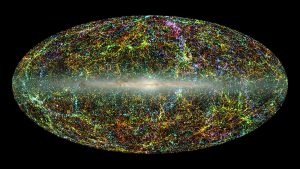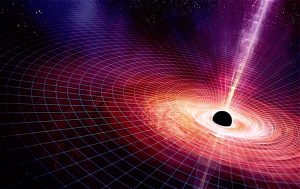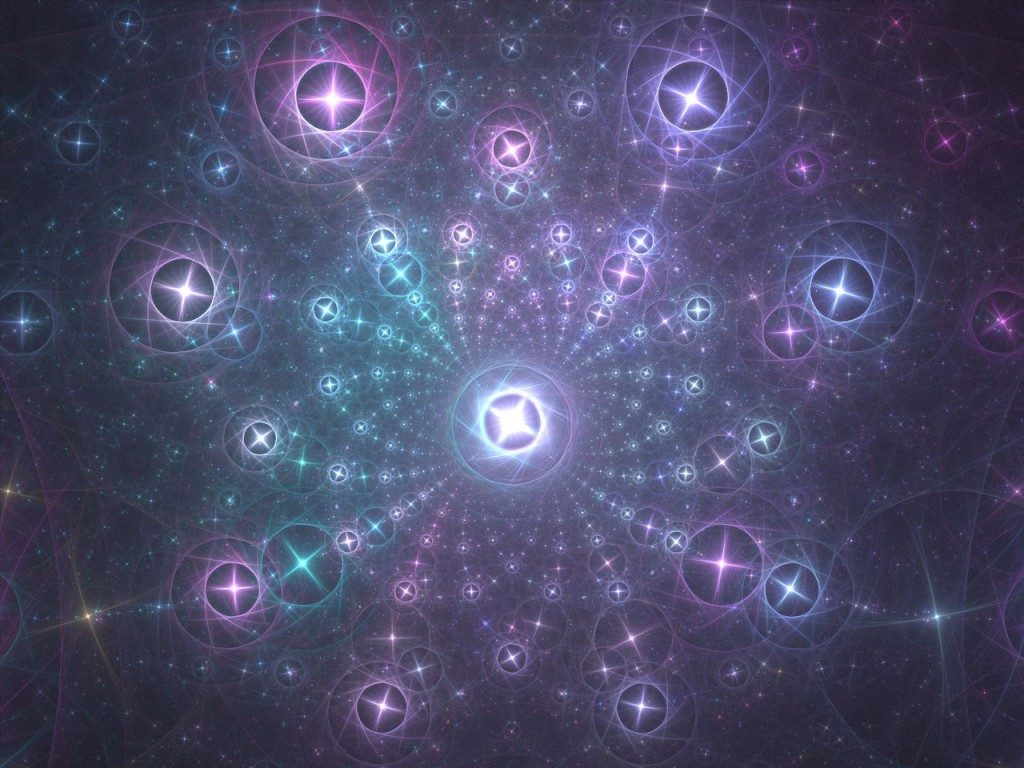Physicists believe that at the tiniest scales, space emerges from quanta.
What might these building blocks look like?
People have always taken space for granted. It is just emptiness, after all—a backdrop to everything else. Time, likewise, simply ticks on incessantly. But if physicists have learned anything from the long slog to unify their theories, it is that space and time form a system of such staggering complexity that it may defy our most ardent efforts to understand.
Albert Einstein saw what was coming as early as November 1916. A year earlier he had formulated his general theory of relativity, which postulates that gravity is not a force that propagates through space but a feature of spacetime itself. When you throw a ball high into the air, it arcs back to the ground because Earth distorts the spacetime around it, so that the paths of the ball and the ground intersect again. In a letter to a friend, Einstein contemplated the challenge of merging general relativity with his other brainchild, the nascent theory of quantum mechanics. That would not merely distort space but dismantle it. Mathematically, he hardly knew where to begin. “How much have I already plagued myself in this way!” he wrote.
Einstein never got very far. Even today there are almost as many contending ideas for a quantum theory of gravity as scientists working on the topic. The disputes obscure an important truth: the competing approaches all say space is derived from something deeper—an idea that breaks with 2,500 years of scientific and philosophical understanding.
[SCIET Dynamic’s Note] This article is posted here because it beautifully presents some core issues regarding the controversy over the competition to describe reality in the realm of very small changes in space. We need to find a General Theory of Spacetime.
SCIET Dynamics seeks to unite the components of SpaceTime into an interdependent set that grows in complexity as it develops. It views the Void(Awareness), Space, Matter and Consciousness as sequences of creation built one upon the other. The Void, called “Awareness” in SD, exists as a sea of extremely small and fast fluctuations, which then gives rise to a burst of energy, labeled the “First Action” which converts the burst into ever smaller increments, or “points of Awareness”, that have the effect of “formatting” the area defined by the original burst of energy. The “formatting” is the byproduct of self-measuring algorithm which reduces uniformly within the original radius of the burst. When the increments reach the size of the original center point they begin to interact, or resonate, with that value. The resonance gives rise to a new quality that allows the information about the change created by movement to bounce off of the center point and be stored in the area around the “point of Awareness”, a phenomenon that is responsible to the formation of spheres that surround every “point of Awareness. All nucleons (Protons, neutrons and electrons) are created by this affect. The same affect is responsible for spherical forms in space of all sizes.
DOWN THE BLACK HOLE
A kitchen magnet neatly demonstrates the problem that physicists face. It can grip a paper clip against the gravity of the entire Earth. Gravity is weaker than magnetism or than electric or nuclear forces. Whatever quantum effects it has are weaker still. The only tangible evidence that these processes occur at all is the mottled pattern of matter in the very early universe—thought to be caused, in part, by quantum fluctuations of the gravitational field.
Black holes are the best test case for quantum gravity. “It’s the closest thing we have to experiments,” says Ted Jacobson of the University of Maryland, College Park. He and other theorists study black holes as theoretical fulcrums. What happens when you take equations that work perfectly well under laboratory conditions and extrapolate them to the most extreme conceivable situation? Will some subtle flaw manifest itself?
General relativity predicts that matter falling into a black hole becomes compressed without limit as it approaches the center—a mathematical cul-de-sac called a singularity. Theorists cannot extrapolate the trajectory of an object beyond the singularity; its time line ends there. Even to speak of “there” is problematic because the very spacetime that would define the location of the singularity ceases to exist. Researchers hope that quantum theory could focus a microscope on that point and track what becomes of the material that falls in.
Out at the boundary of the hole, matter is not so compressed, gravity is weaker and, by all rights, the known laws of physics should still hold. Thus, it is all the more perplexing that they do not. The black hole is demarcated by an event horizon, a point of no return: matter that falls in cannot get back out. The descent is irreversible. That is a problem because all known laws of fundamental physics, including those of quantum mechanics as generally understood, are reversible. At least in principle, you should be able to reverse the motion of all the particles and recover what you had.
A very similar conundrum confronted physicists in the late 1800s, when they contemplated the mathematics of a “black body,” idealized as a cavity full of electromagnetic radiation. James Clerk Maxwell’s theory of electromagnetism predicted that such an object would absorb all the radiation that impinges on it and that it could never come to equilibrium with surrounding matter. “It would absorb an infinite amount of heat from a reservoir maintained at a fixed temperature,” explains Rafael Sorkin of the Perimeter Institute for Theoretical Physics in Ontario. In thermal terms, it would effectively have a temperature of absolute zero. This conclusion contradicted observations of real-life black bodies (such as an oven). Following up on work by Max Planck, Einstein showed that a black body can reach thermal equilibrium if radiative energy comes in discrete units, or quanta.
Theoretical physicists have been trying for nearly half a century to achieve an equivalent resolution for black holes. The late Stephen Hawking of the University of Cambridge took a huge step in the mid-1970s, when he applied quantum theory to the radiation field around black holes and showed they have a nonzero temperature. As such, they can not only absorb but also emit energy. Although his analysis brought black holes within the fold of thermodynamics, it deepened the problem of irreversibility. The outgoing radiation emerges from just outside the boundary of the hole and carries no information about the interior. It is random heat energy. If you reversed the process and fed the energy back in, the stuff that had fallen in would not pop out; you would just get more heat. And you cannot imagine that the original stuff is still there, merely trapped inside the hole, because as the hole emits radiation, it shrinks and, according to Hawking’s analysis, ultimately disappears.
This problem is called the information paradox because the black hole destroys the information about the infalling particles that would let you rewind their motion. If black hole physics really is reversible, something must carry information back out, and our conception of spacetime may need to change to allow for that.
ATOMS OF SPACETIME
Heat is the random motion of microscopic parts, such as the molecules of a gas. Because black holes can warm up and cool down, it stands to reason that they have parts—or, more generally, a microscopic structure. And because a black hole is just empty space (according to general relativity, infalling matter passes through the horizon but cannot linger), the parts of the black hole must be the parts of space itself. As plain as an expanse of empty space may look, it has enormous latent complexity.
Even theories that set out to preserve a conventional notion of spacetime end up concluding that something lurks behind the featureless facade. For instance, in the late 1970s Steven Weinberg, now at the University of Texas at Austin, sought to describe gravity in much the same way as the other forces of nature. He still found that spacetime is radically modified on its finest scales.
Physicists initially visualized microscopic space as a mosaic of little chunks of space. If you zoomed in to the Planck scale, an almost inconceivably small size of 10–35 meter, they thought you would see something like a chessboard. But that cannot be quite right. For one thing, the grid lines of a chessboard space would privilege some directions over others, creating asymmetries that contradict the special theory of relativity. For example, light of different colors might travel at different speeds—just as in a glass prism, which refracts light into its constituent colors. Whereas effects on small scales are usually hard to see, violations of relativity would actually be fairly obvious.
In SCIET Dynamics the “atoms” of space time are perceived to be quantum scale fluctuations that leave tetrahedral tracks as they appear and disappear. The tracks are related to the Event Horizons of Black Holes because they bound the the area between the void and space. In this sense, the tiny “tetrons” are an artifact of the creation of space.
The thermodynamics of black holes casts further doubt on picturing space as a simple mosaic. By measuring the thermal behavior of any system, you can count its parts, at least in principle. Dump in energy and watch the thermometer. If it shoots up, that energy must be spread out over comparatively few molecules. In effect, you are measuring the entropy of the system, which represents its microscopic complexity.
If you go through this exercise for an ordinary substance, the number of molecules increases with the volume of material. That is as it should be: If you increase the radius of a beach ball by a factor of 10, you will have 1,000 times as many molecules inside it. But if you increase the radius of a black hole by a factor of 10, the inferred number of molecules goes up by only a factor of 100. The number of “molecules” that it is made up of must be proportional not to its volume but to its surface area. The black hole may look three-dimensional, but it behaves as if it were two-dimensional.
This weird effect goes under the name of the holographic principle because it is reminiscent of a hologram, which presents itself to us as a three-dimensional object. On closer examination, however, it turns out to be an image produced by a two-dimensional sheet of film. If the holographic principle counts the microscopic constituents of space and its contents—as physicists widely, though not universally, accept—it must take more to build space than splicing together little pieces of it.
The relation of part to whole is seldom so straightforward, anyway. An H2O molecule is not just a little piece of water. Consider what liquid water does: it flows, forms droplets, carries ripples and waves, and freezes and boils. An individual H2O molecule does none of that: those are collective behaviors. Likewise, the building blocks of space need not be spatial. “The atoms of space are not the smallest portions of space,” says Daniele Oriti of the Max Planck Institute for Gravitational Physics in Potsdam, Germany. “They are the constituents of space. The geometric properties of space are new, collective, approximate properties of a system made of many such atoms.”
What exactly those building blocks are depends on the theory. In loop quantum gravity, they are quanta of volume aggregated by applying quantum principles. In string theory, they are fields akin to those of electromagnetism that live on the surface traced out by a moving strand or loop of energy—the namesake string. In M-theory, which is related to string theory and may underlie it, they are a special type of particle: a membrane shrunk to a point. In causal set theory, they are events related by a web of cause and effect. In the amplituhedron theory and some other approaches, there are no building blocks at all—at least not in any conventional sense.
Although the organizing principles of these theories vary, all strive to uphold some version of the so-called relationalism of 17th- and 18th-century German philosopher Gottfried Leibniz. In broad terms, relationalism holds that space arises from a certain pattern of correlations among objects. In this view, space is a jigsaw puzzle. You start with a big pile of pieces, see how they connect and place them accordingly. If two pieces have similar properties, such as color, they are likely to be nearby; if they differ strongly, you tentatively put them far apart. Physicists commonly express these relations as a network with a certain pattern of connectivity. The relations are dictated by quantum theory or other principles, and the spatial arrangement follows.
Phase transitions are another common theme. If space is assembled, it might be disassembled, too; then its building blocks could organize into something that looks nothing like space. “Just like you have different phases of matter, like ice, water and water vapor, the atoms of space can also reconfigure themselves in different phases,” says Thanu Padmanabhan of the Inter-University Center for Astronomy and Astrophysics in India. In this view, black holes may be places where space melts. Known theories break down, but a more general theory would describe what happens in the new phase. Even when space reaches its end, physics carries on.
ENTANGLED WEBS
The big realization of recent years—and one that has crossed old disciplinary boundaries—is that the relevant relations involve quantum entanglement. An extrapowerful type of correlation, intrinsic to quantum mechanics, entanglement seems to be more primitive than space. For instance, an experimentalist might create two particles that fly off in opposing directions. If they are entangled, they remain coordinated no matter how far apart they may be.
Traditionally when people talked about “quantum” gravity, they were referring to quantum discreteness, quantum fluctuations and almost every other quantum effect in the book—but never quantum entanglement. That changed when black holes forced the issue. Over the lifetime of a black hole, entangled particles fall in, but after the hole evaporates fully, their partners on the outside are left entangled with—nothing. “Hawking should have called it the entanglement problem,” says Samir Mathur of Ohio State University.
Even in a vacuum, with no particles around, the electromagnetic and other fields are internally entangled. If you measure a field at two different spots, your readings will jiggle in a random but coordinated way. And if you divide a region in two, the pieces will be correlated, with the degree of correlation depending on the only geometric quantity they have in common: the area of their interface. In 1995 Jacobson argued that entanglement provides a link between the presence of matter and the geometry of spacetime—which is to say, it might explain the law of gravity. “More entanglement implies weaker gravity—that is, stiffer spacetime,” he says.
Several approaches to quantum gravity—most of all, string theory—now see entanglement as crucial. String theory applies the holographic principle not just to black holes but also to the universe at large, providing a recipe for how to create space—or at least some of it. For instance, a two-dimensional space could be threaded by fields that, when structured in the right way, generate an additional dimension of space. The original two-dimensional space would serve as the boundary of a more expansive realm, known as the bulk space. And entanglement is what knits the bulk space into a contiguous whole.
In 2009 Mark Van Raamsdonk of the University of British Columbia gave an elegant argument for this process. Suppose the fields at the boundary are not entangled—they form a pair of uncorrelated systems. They correspond to two separate universes, with no way to travel between them. When the systems become entangled, it is as if a tunnel, or wormhole, opens up between those universes, and a spaceship can go from one to the other. As the degree of entanglement increases, the wormhole shrinks in length, drawing the universes together until you would not even speak of them as two universes anymore. “The emergence of a big spacetime is directly tied into the entangling of these field theory degrees of freedom,” Van Raamsdonk says. When we observe correlations in the electromagnetic and other fields, they are a residue of the entanglement that binds space together.
Many other features of space, besides its contiguity, may also reflect entanglement. Van Raamsdonk and Brian Swingle, now at the University of Maryland, College Park, argue that the ubiquity of entanglement explains the universality of gravity—that it affects all objects and cannot be screened out. As for black holes, Leonard Susskind of Stanford University and Juan Maldacena of the Institute for Advanced Study in Princeton, N.J., suggest that entanglement between a black hole and the radiation it has emitted creates a wormhole—a back-door entrance into the hole. That may help preserve information and ensure that black hole physics is reversible.
Whereas these string theory ideas work only for specific geometries and reconstruct only a single dimension of space, some researchers have sought to explain how all of space can emerge from scratch. For instance, ChunJun Cao, Spyridon Michalakis and Sean M. Carroll, all at the California Institute of Technology, begin with a minimalist quantum description of a system, formulated with no direct reference to spacetime or even to matter. If it has the right pattern of correlations, the system can be cleaved into component parts that can be identified as different regions of spacetime. In this model, the degree of entanglement defines a notion of spatial distance.
In physics and, more generally, in the natural sciences, space and time are the foundation of all theories. Yet we never see spacetime directly. Rather we infer its existence from our everyday experience. We assume that the most economical account of the phenomena we see is some mechanism that operates within spacetime. But the bottom-line lesson of quantum gravity is that not all phenomena neatly fit within spacetime. Physicists will need to find some new foundational structure, and when they do, they will have completed the revolution that began just more than a century ago with Einstein.
 In a new paper that appeared on the physics preprint site, arxiv.org, on Sunday, Loeb and two Harvard colleagues, Xingang Chen and Zhong-Zhi Xianyu, suggested such a guillotine. The researchers predicted an oscillatory pattern in the distribution of matter throughout the cosmos that, if detected, could distinguish between inflation and alternative scenarios — particularly the hypothesis that the Big Bang was actually a bounce preceded by a long period of contraction.
In a new paper that appeared on the physics preprint site, arxiv.org, on Sunday, Loeb and two Harvard colleagues, Xingang Chen and Zhong-Zhi Xianyu, suggested such a guillotine. The researchers predicted an oscillatory pattern in the distribution of matter throughout the cosmos that, if detected, could distinguish between inflation and alternative scenarios — particularly the hypothesis that the Big Bang was actually a bounce preceded by a long period of contraction.











Recent Comments